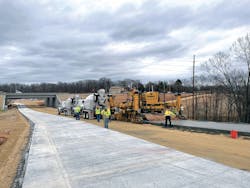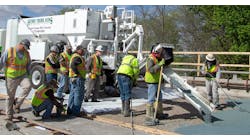By Eric Ferrebee and Jim Mack, Contributing Authors
Concrete has a proven record of being a viable paving material. When America’s interstate system was being built in the 1950s, concrete was the most common paving material. Its decline in use can be attributed to a lack of knowledge on concrete in general, but specifically in regard to repair, maintenance, and replacement activities.
Concrete’s decline has been gradual. Asphalt use has increased as budgets have shifted towards preservation rather than rehabilitation and reconstruction. However, with renewed education efforts, and a greater need for more permanent solutions, interindustry competition levels (between firms that pave with different materials) can increase while cutting costs.
Improving interindustry competition brings additional contractors to the bidding process and a second level of competition into the supply chain (e.g., the asphalt, concrete, and cement suppliers).
While these suppliers may not directly compete against each other, the sustained competitive pressures between the industries drives costs lower as supply chains get established, skilled personnel develop, construction quality improves, innovation is spurred, and risks decline.
The MIT Concrete Sustainability Hub (CSHub) examined state Department of Transportation (DOT) pavement bid data collected between 2005 and 2018. The data showed how the split of DOT paving expenditures between industries affected paving unit costs.
DOT spending on concrete and asphalt paving materials varied greatly from state to state. However, Iowa and Wisconsin spent more than 40% of their paving budget on concrete pavements while 22 states spent over 90% of their paving budget on asphalt pavements.
The amount of intra-industry competition (between firms that pave with the same material) is not as high as it could be. Some states often had only one or two bidders for many of their projects. Yet the key to competition is having a healthy multi-bidder environment.
Next, CSHub evaluated and analyzed the bid results for the given period. CSHub compared weighted unit costs versus a five-year average balance of DOT pavement type usage for asphalt and concrete pavements.
CSHub also developed statistical models to determine what factors have a significant influence on paving material costs. This included items like project size, the amount of paving material used, the number of bidders (a metric of intra-industry competition), and the average share of spending in a state on concrete (a metric of inter-industry competition). Bid costs were adjusted to account for year-to-year cost changes.
For asphalt paving, project size was the most influential factor that affected unit costs. It was followed by interindustry competition. It was reversed for concrete paving. Interindustry competition was the most influential factor, followed by project size.
Because interindustry competition is the first or second most influential item, the data shows that when competition between paving industries increases, there is a clear trend toward lower unit costs for concrete and asphalt pavements.
The results also showed a decrease in variability in unit costs for both material that accompanied increasing levels of interindustry competition.
It is important to note that states with higher levels of competition tended to be the states with stable and predictable paving programs. This implies that sustained programs, for both concrete and asphalt, are important in maintaining predictable and low unit costs.
Once researchers determined the key factors, they again used statistical modelling to estimate how increasing interindustry competition would affect paving costs. Overall, they found that as interindustry competition increased, the unit costs of concrete and asphalt paving materials fell significantly—particularly those of concrete.
For example, if a state with a low concrete market share (e.g., 1 %) increased its concrete market share to 25%, it would lower concrete and asphalt paving material unit costs by around 29% and 8%, respectively. This allows states to buy more paving materials.
The Rise in Prices
Data from the Bureau of Labor Statistics (BLS) show that the 50-year price trend for paving with asphalt has gone up starkly when compared to general inflation rates and concrete.
This is unsurprising as the price for liquid asphalt is volatile, with yearly swings often exceeding 40%. In addition, when only one material is being used, demand causes saturation, which increases the price.
Asphalt is a high-demand product. So, when asphalt plants become engaged, saturation occurs and prices rise in the absence of new entrants or alternative materials to compete and drive prices back down. These asphalt price change drivers can be offset if there are alternative materials in the market.
When they do choose concrete pavement, agencies often make the selection based on its durability and longevity (qualities which do contribute to cost reduction when life cycle cost analysis is employed).
Recent bids across the U.S., however, have illustrated that concrete can also be successful on an initial cost basis, which has been the case even with accelerated construction projects.
The key is to make materials decisions early and create job-specific designs. An example is work done by the Impactful Resilient Infrastructure Science and Engineering (IRISE) consortium, established through the University of Pittsburgh.
IRISE helped one project team in Pennsylvania lower the initial cost of concrete by eliminating a high early strength concrete mix and testing and using, instead, a maturity method for determining the concrete’s strength gain.
Starting a Competitive Paving Program
Implementing a competitive paving program in an agency needs to be done at the programmatic level and the project level. At the programmatic level, the first steps are planning and communication. It indicates that the agency is committed to a program that will foster competition.
When the team identifies projects in which concrete or asphalt could each provide a viable solution, they should make a deliberate decision to go with the less dominant material to create a competitive market.
Similarly, the agency should look for cement-based solutions in multiple applications (e.g., interstates, state highways, rural roads, intersections, roundabouts, ramps, etc.) so that opportunities for contractors of all sizes are developed.
Next, the agency should assign a given number of concrete projects each year, as they do asphalt, and develop a project pipeline that covers several years. Finally, technical task forces will be needed to address issues with specifications, design procedures, and other issues that arise.
For individual pavement projects, strategies for achieving value include: optimizing concrete designs to avoid over-design, looking at multiple solutions (e.g., new concrete pavement, concrete overlays, RCC, etc.), performing life cycle cost analysis, and using alternate pavement bidding.
Alternate pavement bidding is process where two equivalent pavement designs are developed for a given project and the contractor chooses which pavement to submit for his bid. To implement an alternate pavement bidding program, agencies should follow the process outlined by the Federal Highway Administration (FHWA) in their guidance on alternate pavement bidding.
Several states have a successful history of creating project pipelines that include asphalt and concrete, and their practices can serve as models.
Some states use a strategy of designating a target number for concrete installations. For its new roads, the Florida Department of Transportation targets approximately 40 miles of concrete pavement per year. Similarly, Texas Department of Transportation has an established practice of bidding approximately 5 million square yards of concrete every year. That represents approximately 26% of its projects.
Other states balance the market based on a metric such as volume. Wisconsin and Michigan attempt to balance the tonnage of asphalt each year to the square yards of concrete pavement that is placed. This system is advantageous because each industry participates in times when funding is plentiful, and they take similar reductions when funding levels are lower.
Another approach is to use traffic or road classifications to designate specific markets for each product. In the past, Minnesota Department of Transportation based product decisions on equivalent single axle load (ESAL) values.
Projects under 1 million ESALs were constructed of asphalt. Projects over 7 million ESALs were constructed of concrete, and projects between 1 million and 7 million ESALs went through a life cycle cost analysis to determine the most appropriate material.
The research shows—and the experiences of multiple states bear out—that it is a myth that there’s no way to lower the unit cost of a pavement. Encouraging competition between paving materials is a clear strategy that would cause costs for all materials to go down. RB
Eric Ferrebee is the senior director of technical services at the American Concrete Pavement Association. Jim Mack is the past president of the board at the American Concrete Pavement Association and director of infrastructure and sustainability at CEMEX.



